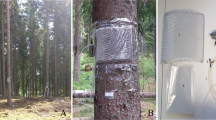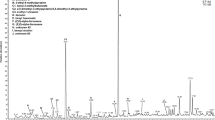Abstract
This report presents the first quantitative estimates of emission rates for chemical signals in a bird—the crested auklet (Aethia cristatella). Volatile emissions from live birds were captured in a purified airstream onto polymer traps. Traps were eluted with methanol and analyzed with gas chromatography-mass spectrometry. The volatile collection chamber was field-calibrated with an in-line bubbler and synthetic octanal, the dominant constituent of the crested auklet’s citruslike odor. The result is an index of volatile chemical emissions within a small population of wild crested auklets at Big Koniuji Island, AK, USA. The average emission rate for octanal was 5.7 μl/50 min. Males and females did not differ in their emission rates (t (0.05)two-tailed = 0.44, P = 0.66). There was a sevenfold difference between minimum and maximum emission rates. Prevalence of tick infection (2%) was low despite the high abundance of ticks in the colony. The crested auklet with the lowest chemical emission rate was heavily parasitized by ticks.

Similar content being viewed by others
References
Barton, T. R., Harris, M. P., Wanless, S., and Elston, D. A. 1996. The activity periods and life-cycle of the tick Ixodes uriae (Acari: Ixodidae) in relation to host breeding strategies. Parasitology 112:571–580.
Clark, L. and Mason, J. R. 1985. Use of nest material as insecticidal and anti-pathogenic agents by the European starling. Oecologia 67:169–176.
Clark, L. and Mason, J. R. 1988. Effect of biologically active plants used as nest material and the derived benefit to starling nests. Oecologia 77:174–180.
Clayton, D. H. and Vernon, J. G. 1993. Common grackle anting with lime fruit and its effects on ectoparasites. Auk 110:951–952.
Clayton, D. H. and Walther, B. A. 1997. Collection and quantification of arthropod parasites of birds, pp. 419–440, in D. H. Clayton and J. Moore (eds.). Host–Parasite Evolution: General Principles and Avian Models. Oxford University Press, Oxford, England.
Clayton, D. H. and Drown, D. M. 2001. Critical evaluation of five methods for quantifying chewing lice (Insecta: Phthiraptera). J. Parasitol. 87:1291–1300.
Douglas, H. D. III, 2006. Odors and ornaments in crested auklets (Aethia cristatella): Signals of mate quality? Ph.D. thesis, University of Alaska Fairbanks, pp. 217.
Douglas, H. D. III, Co, J. E., Jones, T. H., and Conner, W. E. 2001. Heteropteran chemical repellents identified in the citrus odor of a seabird (Crested Auklet: Aethia cristatella). Naturwissenschaften 88:330–332.
Douglas, H. D. III, Co, J. E., Jones, T. H., and Conner, W. E. 2004. Interspecific differences in Aethia spp. auklet odorants and evidence for chemical defense against ectoparasites. J. Chem. Ecol. 30:1921–1935.
Douglas, H. D. III, Malenke, J. R., and Clayton, D.H. 2005a. Is the citrus-like plumage odorant of crested auklets (Aethia cristatella) a defense against lice? J. Ornithol. 146:111–115.
Douglas, H. D. III, Co, J. E., Jones, T.H., Conner, W. E., and Day, J. F. 2005b. Chemical odorant of colonial seabird repels mosquitoes. J. Med. Entomol. 42:647–651.
Dumbacher, J. P. 1999. Evolution of toxicity in Pitohuis I: Effects of homobatrachotoxin on chewing lice. Auk 116:957–963.
Dumbacher, J. P., Beehler, B. M., Spande, T. F., Garraffo, H. M., and Daly, J. W. 1992. Homobatrachotoxin in the genus Pitohui: Chemical defense in birds? Science 258:799–801.
Dumbacher, J. P., Spande, T. F., and Daly, J. W. 2000. Batrachotoxin alkaloids from passerine birds: A second toxic bird genus (Ifrita kowaldi) from New Guinea. Proc. Natl. Acad. Sci. USA 97:12970–12975.
Dumbacher, J. P., Wako, A., Derrickson, S. R., Samuelson, A., Spande, T. F., and Daly, J. W. 2005. Melyrid beetles (Choresine): A putative source for the batrachotoxin alkaloids found in poison-dart frogs and toxic passerine birds. Proc. Natl. Acad. Sci. USA 101:15857–15860.
Ehrlich, P. R., Dobkin, S., and Wheye, D. 1986. The adaptive significance of anting. Auk 103:835.
Gauthier-Clerc, M., Clerquin, Y., and Handrich, Y. 1998. Hyperinfestation by ticks Ixodes uriae: A possible cause of death in adult King Penguins, a long-lived seabird. Colon. Waterbirds 21:229–233.
Gwinner, H., Oltrogge, M., Trost, L., and Nienaber, U. 2000. Green plants in starling nests: Effects on nestlings. Anim. Behav. 59:301–309.
Hagelin, J. C., Jones, I. L., and Rasmussen, L. E. L. 2003. A tangerine-scented social odour in a monogamous bird. Proc. R. Soc. B 270:1323–1329.
Hunter, F. M. and Jones, I. L. 1999. The frequency and function of aquatic courtship and copulation in least, crested, whiskered, and parakeet auklets. Condor 101:518–528.
Jones, I. L. 1993a. Sexual differences in bill shape and external measurements of Crested Auklets. Wilson Bull. 105:525–529.
Jones, I. L. 1993b. Crested Auklet (Aethia cristatella), in A. Poole and F. Gill (eds.). The Birds of North America, No. 70. Acad. of Nat. Sci. and Am. Ornithol. Union, Philadephia, PA.
Jones, I. L., Hagelin, J. C., Major, H. L., and Rasmussen, L. E. L. 2004. An experimental field study of the function of crested auklet feather odor. Condor 106:71–78.
Kebede, A. G. 2004. Seasonal dynamics of ticks (Amblyomma cohaerens and Boophilus decoloratus) and development of a management plan for tick and tick born diseases control on cattle in Jimma zone, Southwestern Ethiopia. PhD dissertation, Georg-August-University, Göttingen.
Lafuma, L., Lambrechts, M. M., and Raymond, M. 2001. Aromatic plants in bird nests as a protection against blood-sucking flying insects? Behav. Process. 56:113–120.
Lasiewski, R. C. and Dawson, W. R. 1967. A reexamination of the relation between standard metabolic rate and body weight in birds. Condor 69:13–23.
Mouritsen, K. N. and Madsen, J. 1994. Toxic birds: Defence against parasites? Oikos 69:357–358.
Parkes, K. C., Weldon, P. J., and Hoffman, R. L. 2003. Polydesmidan millipede used in self-anointing by a strong-billed woodcreeper (Xiphocolaptes promeropirhynchus) from Belize. Ornitol. Neotrop. 14:285–286.
Penn, D. and Potts, W. 1998. Chemical signals and parasite-mediated sexual selection. Trends Ecol. Evol. 13:391–396.
Reed, K. D., Meece, J. K., Henkel, J. S., and Shukla, S. K. 2003. Birds, migration, and emerging zoonoses: West Nile virus, Lyme disease, influenza A and enteropathogens. Clin. Med. Res. 1:5–12.
Schmidt-Nielsen, K. 1997. Animal Physiology: Adaptation and Environment. Cambridge University Press, Cambridge, United Kingdom.
Simmons, K. E. L. 1966. Anting and the problem of self-stimulation. J. Zool. (Lond.) 149:145–162.
Sonenshine, D. E. 1985. Pheromones and other semiochemicals of the Acari. Annu. Rev. Entomol. 30:1–28.
Turlings, T. C. J., Tumlinson, J. H., Heath, R. R., Proveaux, A. T., and Doolittle, R. E. 1991. Isolation and identification of allelochemicals that attract the larval parasitoid, Cotesia marginiventris, (Cresson), to the microhabitat of one of its hosts. J. Chem. Ecol. 17:2235–2251.
Visnak, R. M. and Dumbacher, J. P. 1999. Comparison of four fumigants for removing avian lice. J. Field Ornithol. 70:42–48.
Weldon, P. J. 2004. Defensive anointing: Extended chemical phenotype and unorthodox ecology. Chemoecology 14:1–4.
Weldon, P. J. and Rappole, J. H. 1997. A survey of birds odorous or unpalatable to humans: Possible indications of chemical defense. J. Chem. Ecol. 23:2609–2633.
Acknowledgments
Laboratory analyses were made possible by the support of the Dept. of Chemistry and Biochemistry, Univ. of Alaska Fairbanks. Professors R. Stolzberg and T. Clausen offered suggestions and assistance. Research was supported with grants from the Eppley Foundation for Research, Inc., and the Angus Gavin Memorial Bird Research Fund, Univ. of Alaska Foundation. Logistical support was also provided in part by a grant from the Center for Global Change and Arctic System Research sponsored by the Alaska Sea Grant College Program. A. Springer helped support this research. A. Kelly and A. Maccormack assisted with fieldwork. J. Galvin and the Rita B F/V provided logistical support. The Alaska Maritime Natl. Wild. Refuge and the Aleut Corp. granted research permits. T. Jones, W. Conner, and W. Simpson offered suggestions on design of the volatile collection system. Ø. Tøien checked the calibration of flowmeters.
Author information
Authors and Affiliations
Corresponding author
Rights and permissions
About this article
Cite this article
Douglas, H.D. Measurement of Chemical Emissions in Crested Auklets (Aethia cristatella). J Chem Ecol 32, 2559–2567 (2006). https://doi.org/10.1007/s10886-006-9164-2
Published:
Issue Date:
DOI: https://doi.org/10.1007/s10886-006-9164-2




